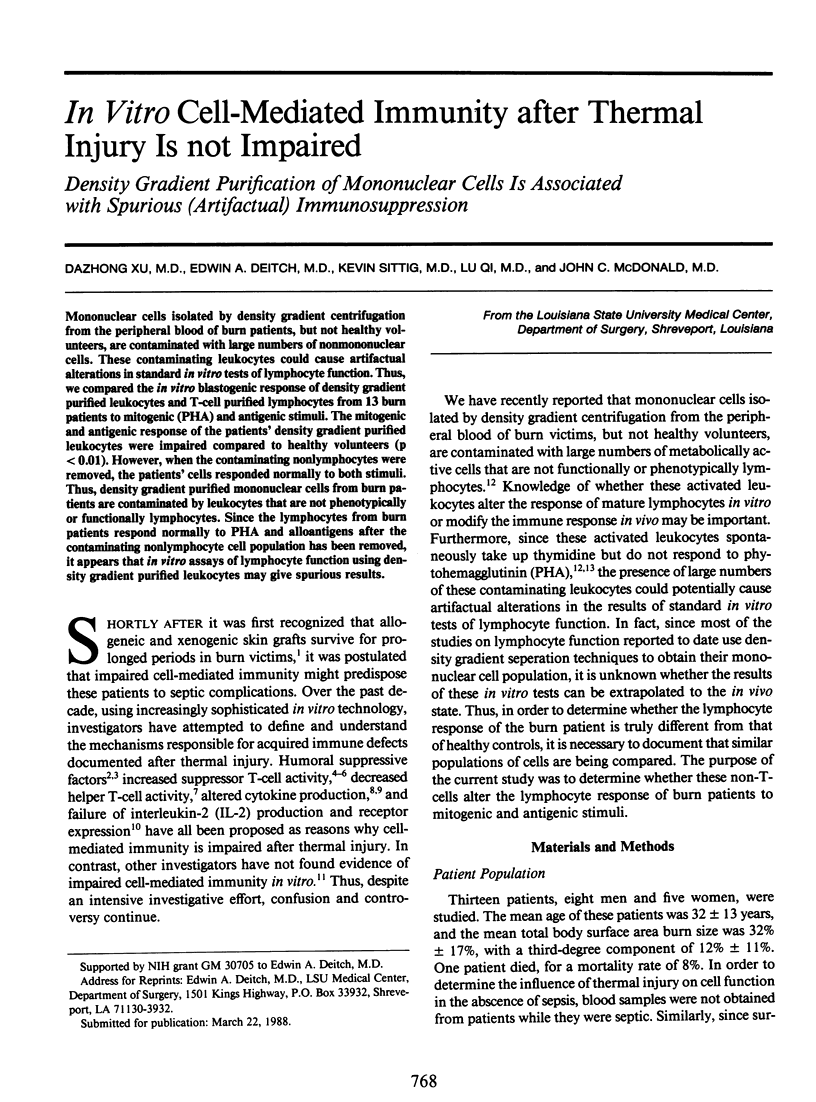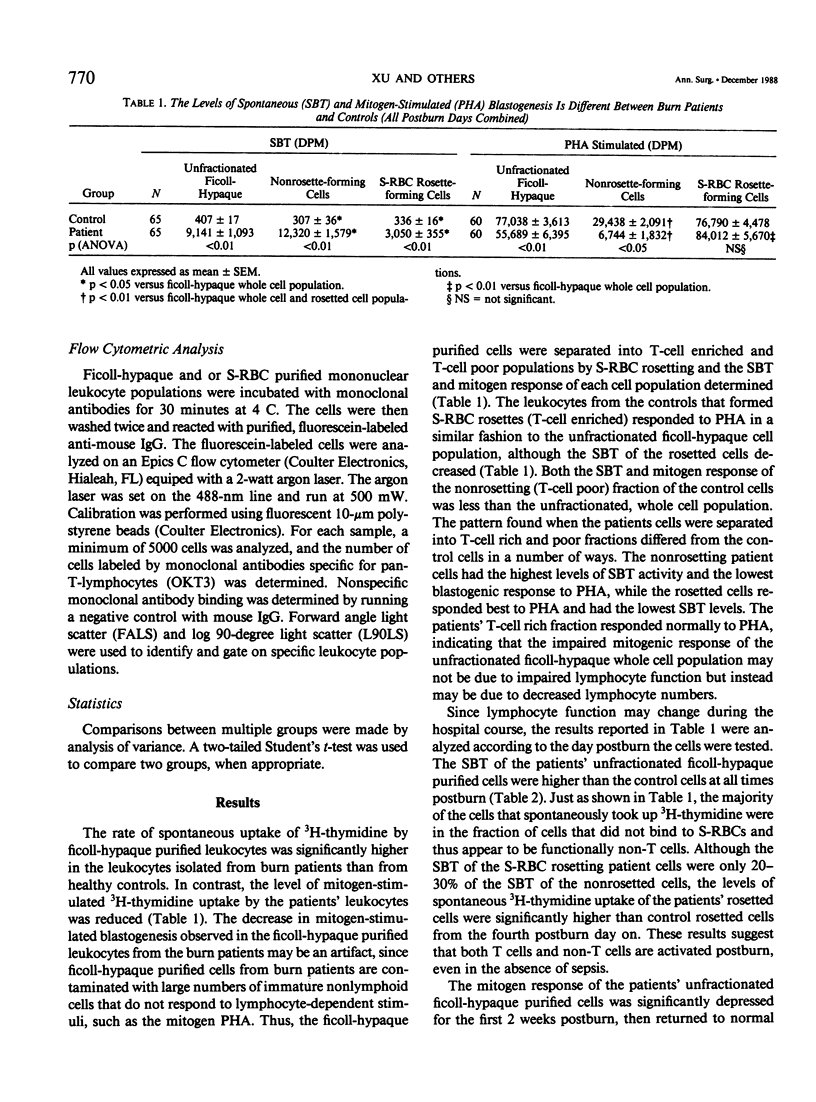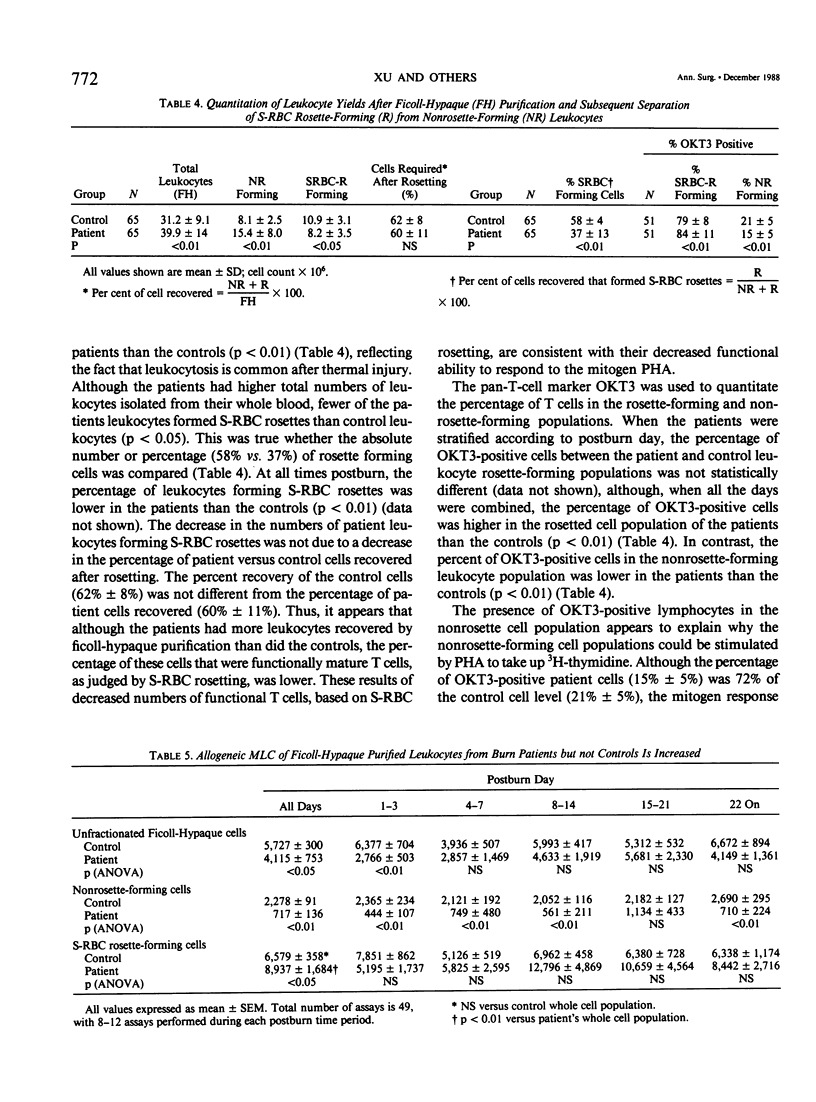Abstract
Mononuclear cells isolated by density gradient centrifugation from the peripheral blood of burn patients, but not healthy volunteers, are contaminated with large numbers of nonmononuclear cells. These contaminating leukocytes could cause artifactual alterations in standard in vitro tests of lymphocyte function. Thus, we compared the in vitro blastogenic response of density gradient purified leukocytes and T-cell purified lymphocytes from 13 burn patients to mitogenic (PHA) and antigenic stimuli. The mitogenic and antigenic response of the patients' density gradient purified leukocytes were impaired compared to healthy volunteers (p less than 0.01). However, when the contaminating nonlymphocytes were removed, the patients' cells responded normally to both stimuli. Thus, density gradient purified mononuclear cells from burn patients are contaminated by leukocytes that are not phenotypically or functionally lymphocytes. Since the lymphocytes from burn patients respond normally to PHA and alloantigens after the contaminating nonlymphocyte cell population has been removed, it appears that in vitro assays of lymphocyte function using density gradient purified leukocytes may give spurious results.
Full text
PDF







Selected References
These references are in PubMed. This may not be the complete list of references from this article.
- Antonacci A. C., Calvano S. E., Reaves L. E., Prajapati A., Bockman R., Welte K., Mertelsmann R., Gupta S., Good R. A., Shires G. T. Autologous and allogeneic mixed-lymphocyte responses following thermal injury in man: the immunomodulatory effects of interleukin 1, interleukin 2, and a prostaglandin inhibitor, WY-18251. Clin Immunol Immunopathol. 1984 Feb;30(2):304–320. doi: 10.1016/0090-1229(84)90064-3. [DOI] [PubMed] [Google Scholar]
- Antonacci A. C., Reaves L. E., Calvano S. E., Amand R., De Riesthal H. F., Shires G. T. Flow cytometric analysis of lymphocyte subpopulations after thermal injury in human beings. Surg Gynecol Obstet. 1984 Jul;159(1):1–8. [PubMed] [Google Scholar]
- Baker C. C., Miller C. L., Trunkey D. D. Predicting fatal sepsis in burn patients. J Trauma. 1979 Sep;19(9):641–648. doi: 10.1097/00005373-197909000-00001. [DOI] [PubMed] [Google Scholar]
- Böyum A. Isolation of mononuclear cells and granulocytes from human blood. Isolation of monuclear cells by one centrifugation, and of granulocytes by combining centrifugation and sedimentation at 1 g. Scand J Clin Lab Invest Suppl. 1968;97:77–89. [PubMed] [Google Scholar]
- Constantian M. B. Association of sepsis with an immunosuppressive polypeptide in the serum of burn patients. Ann Surg. 1978 Aug;188(2):209–215. doi: 10.1097/00000658-197808000-00014. [DOI] [PMC free article] [PubMed] [Google Scholar]
- Constantian M. B. Impaired reactivity of burn patient lymphocytes to phytohemagglutinin in autologous serum: failure to improve responsiveness by washing in vitro. J Surg Res. 1979 Aug;27(2):84–92. doi: 10.1016/0022-4804(79)90114-8. [DOI] [PubMed] [Google Scholar]
- Deitch E. A., Landry K. N., McDonald J. C. Postburn impaired cell-mediated immunity may not be due to lazy lymphocytes but to overwork. Ann Surg. 1985 Jun;201(6):793–802. doi: 10.1097/00000658-198506000-00018. [DOI] [PMC free article] [PubMed] [Google Scholar]
- Mahler D., Batchelor J. R. Phytohaemagglutinin transformation of lymphocytes in burned patients. Transplantation. 1971 Nov;12(5):409–411. doi: 10.1097/00007890-197111000-00015. [DOI] [PubMed] [Google Scholar]
- McDonald J. C., Lee J. H. "Spontaneous" blastogenic transformation. A monitor of immunosuppression. Arch Surg. 1974 Aug;109(2):320–325. doi: 10.1001/archsurg.1974.01360020180035. [DOI] [PubMed] [Google Scholar]
- McIrvine A. J., O'Mahony J. B., Saporoschetz I., Mannick J. A. Depressed immune response in burn patients: use of monoclonal antibodies and functional assays to define the role of suppressor cells. Ann Surg. 1982 Sep;196(3):297–304. doi: 10.1097/00000658-198209000-00008. [DOI] [PMC free article] [PubMed] [Google Scholar]
- Miller C. L., Baker C. C. Changes in lymphocyte activity after thermal injury. The role of suppressor cells. J Clin Invest. 1979 Feb;63(2):202–210. doi: 10.1172/JCI109290. [DOI] [PMC free article] [PubMed] [Google Scholar]
- Munster A. M., Winchurch R. A., Birmingham W. J., Keeling P. Longitudinal assay of lymphocyte responsiveness in patients with major burns. Ann Surg. 1980 Dec;192(6):772–775. doi: 10.1097/00000658-198012000-00013. [DOI] [PMC free article] [PubMed] [Google Scholar]
- Ninnemann J. L. Immunosuppression following thermal injury through B cell activation of suppressor T cells. J Trauma. 1980 Mar;20(3):206–213. doi: 10.1097/00005373-198003000-00003. [DOI] [PubMed] [Google Scholar]
- Ozkan A. N., Ninnemann J. L. Suppression of in vitro lymphocyte and neutrophil responses by a low molecular weight suppressor active peptide from burn-patient sera. J Clin Immunol. 1985 May;5(3):172–179. doi: 10.1007/BF00915508. [DOI] [PubMed] [Google Scholar]
- RAPAPORT F. T., CONVERSE J. M., HORN L., BALLANTYNE D. L., Jr, MULHOLLAND J. H. ALTERED REACTIVITY OF SKIN HOMOGRAFTS IN SEVERE THERMAL INJURY. Ann Surg. 1964 Mar;159:390–395. doi: 10.1097/00000658-196403000-00010. [DOI] [PMC free article] [PubMed] [Google Scholar]
- Teodorczyk-Injeyan J. A., Sparkes B. G., Mills G. B., Falk R. E., Peters W. J. Impaired expression of interleukin-2 receptor (IL2R) in the immunosuppressed burned patient: reversal by exogenous IL2. J Trauma. 1987 Feb;27(2):180–187. doi: 10.1097/00005373-198702000-00015. [DOI] [PubMed] [Google Scholar]
- Volenec F. J., Wood G. W., Mani M. M., Robinson D. W., Humphrey L. J. Mononuclear cell analysis of peripheral blood from burn patients. J Trauma. 1979 Feb;19(2):86–93. doi: 10.1097/00005373-197902000-00002. [DOI] [PubMed] [Google Scholar]
- Wenzel K. L., Ichiki A. T. A subpopulation of T cells detected by AET-treated sheep erythrocytes. Clin Immunol Immunopathol. 1977 Jul;8(1):73–79. doi: 10.1016/0090-1229(77)90093-9. [DOI] [PubMed] [Google Scholar]
- Wolfe J. H., Saporoschetz I., Young A. E., O'Connor N. E., Mannick J. A. Suppressive serum, suppressor lymphocytes, and death from burns. Ann Surg. 1981 Apr;193(4):513–520. [PMC free article] [PubMed] [Google Scholar]
- Wolos J. A., Davey F. R. T-cell subpopulations in the autologous and allogeneic mixed lymphocyte reaction. Cell Immunol. 1979 Dec;48(2):415–419. doi: 10.1016/0008-8749(79)90136-9. [DOI] [PubMed] [Google Scholar]
- Wood J. J., O'Mahony J. B., Rodrick M. L., Mannick J. A. Immature T lymphocytes after injury characterized by morphology and phenotypic markers. Ann Surg. 1987 Nov;206(5):564–571. doi: 10.1097/00000658-198711000-00002. [DOI] [PMC free article] [PubMed] [Google Scholar]
- Wood J. J., Rodrick M. L., O'Mahony J. B., Palder S. B., Saporoschetz I., D'Eon P., Mannick J. A. Inadequate interleukin 2 production. A fundamental immunological deficiency in patients with major burns. Ann Surg. 1984 Sep;200(3):311–320. doi: 10.1097/00000658-198409000-00008. [DOI] [PMC free article] [PubMed] [Google Scholar]


